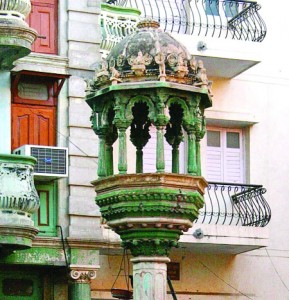Chabutara
(Created page with "{| class="wikitable" |- |colspan="0"|<div style="font-size:100%"> This is a collection of articles archived for the excellence of their content.<br/> </div> |} [[Category:Ind...") |
m (Pdewan moved page Chabutaras to Chabutara without leaving a redirect) |
Revision as of 22:01, 14 September 2017
This is a collection of articles archived for the excellence of their content. |
Chabutaras
Maneka Sanjay Gandhi,Vanishing Chabutaras "Daily Excelsior" 7/2/2016
One of the most beautiful traditions of India, which has now almost disappeared in every part of India except at the entrance or centre of villages in Gujarat and a few places in Rajasthan and Maharashtra, is the Chabutara, a tower-like structure with octagonal or pentagonal shaped enclosures at the top. On the roof are several holes, wherein birds can make their nests. Inside this structure birds, mostly pigeons now, reside and breed. The structure is supported by a pillar. At the base of the structure there is a sitting platform where villagers can sit and talk. The distance between species becomes happily blurred. People learn to live with and encourage birds.
The more common Chabutara in these states is designed only for feeding and resting. The enclosure of such Chabutras is designed like an octagonal house with a conical dome and with windows. Known as the ek-dandia Chabutaras, it is essentially a platform covered with a dome or hood and mounted on a 5-6 feet high pole. On the platform a dish of water and some food is put for the birds.
Some chabutaras can be as large as a room. Built from stone and bricks, these are elevated platforms which provide refuge to a variety of birds, ranging from the small sized sparrows, mynas and pigeons to large ones such as peacocks.
The Gujarati Chabutara comes from the word Kabutar or pigeon. Loosely translated it means pigeon tower. It has always been considered auspicious by farming and trading communities to feed birds – and it is indeed, since birds eat the pests of the fields and spread the seeds of plants and trees. Even now you can see early risers in these villagers coming with small bags of grain for the chabutra. In Kutch the Chabutara is found in the villages where Mistris , master craftsmen, live who specialize in such construction.
One of the best known Chabutaras outside Gujarat is in Raigarh, Chhatisgarh, just outside the railway station. Built in 1900 by a railway contractor and entrepreneur – also a Mistri from Kutch- who believed his luck in business came from the birds, it has become the landmark of the town.
Outside Gujarat, the Chabutara in Madhya Pradesh and Rajasthan is mainly associated with the royal palaces or temples. It is not meant for pigeons but for all kinds of birds. You can see most of these chabutaras now in antique shops being bought as beautiful, carved folk art investments that embellish fashionable gardens rather than for the vital work they represent. Once bought they become ornamental and no grain is put in them lest the piece be spoilt by pigeon faeces. Chabutaras still exist in public places but their tall majesty is now gone – they are old, rotting empty umbrellas, plastered with paint or sporting bill boards and loud speakers. They are ignored by the birds.
There are many explanations for the chabutaras. According to the people of Rajasthan, messages were carried across India through pigeons. The royal families put these chabutaras so that these messengers could rest and eat. In Gujarat, the chabutaros have a deep religious significance. The architecture is a fusion of Hindu and Muslim designs but the soul is Jain and embraces all beings. Many communities believe that the souls of ancestors go into animals and birds and by feeding them they are simply feeding their own families. The Chabutara in many villages was designed to be the centre of community life where the celebration of festivals takes place.
The chabutara stands for the tradition of gentleness that denoted India – Our concern about all life forms, Our willingness to live and help live. Even today it gladdens my heart when I see that specific road dividers in Delhi have become the flat chabutaras of the city. People come early in the morning, on their way to work and pour out grains to hundreds of pigeons who fly in from all over the city to eat. I have one such road divider triangle near my house. I have made homes for the pigeons inside my verandah, by hanging wire mesh baskets lined with paper, from the ceiling. A dozen pigeons live and have their babies here but they go and eat at this common feeding ground.
Ahmedabad Municipal Corporation, and an NGO called Samast Mahajan, has done a survey of old chabutaras in the city. They have found 126 in the old city. Some of these, even though they are now in poor localities, are being maintained by the community who have not let their meagre incomes get in the way of looking after those that are even less well off. Some chabutaras are being maintained by philanthropic business houses.
All is not lost. New Chabutaras have been seen in middle income areas. They do not have the grace and beauty of the old ones, being made of steel bricks and stone. Some of them have ladders which allow people to climb up and put the food and water. But they exist. The departed are being remembered, the birds still come. The symbolism of the average Indian’s concern for dependent creatures still exists. We are the only country in the world where an entire tradition of living with birds has been maintained over so many generations. Perhaps if Uttar Pradesh had this tradition it would have been a better place to live in.
